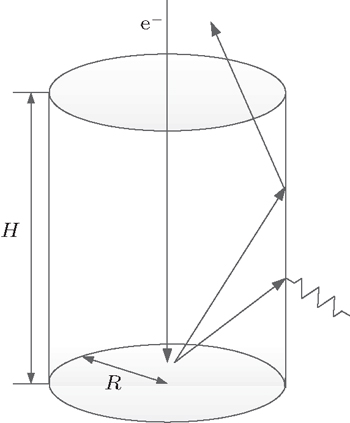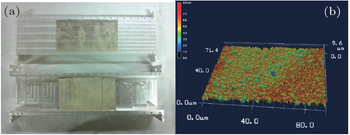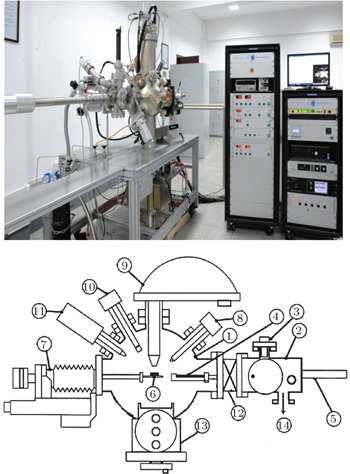† Corresponding author. E-mail:
Project supported by the National Natural Science Foundation of China (Grant No. U1537211), the National Key Laboratory Key Foundation, China (Grant No. 9140C530101150C53011), and China Postdoctoral Science Foundation (Grant No. 2015M572661XB).
Multipaction, caused by the secondary electron emission phenomenon, has been a challenge in space applications due to the resulting degradation of system performance as well as the reduction in the service life of high power components. In this paper we report a novel approach to realize an effective increase in the multipaction threshold by employing micro-porous surfaces. Two micro-porous structures, i.e., a regular micro-porous array fabricated by photolithography pattern processing and an irregular micro-porous array fabricated by a direct chemical etching technique, are proposed for suppressing the secondary electron yield (SEY) and multipaction in components, and the benefits are validated both theoretically and experimentally. These surface processing technologies are compatible with the metal plating process, and offer substantial flexibility and accuracy in topology design. The suppression effect is quantified for the first time through the proper fitting of the surface morphology and the corresponding secondary emission properties. Insertion losses when using these structures decrease dramatically compared with regular millimeter-scale structures on high power dielectric windows. SEY tests on samples show that the maximum yield of Ag-plated samples is reduced from 2.17 to 1.58 for directly chemical etched samples. Multipaction testing of actual C-band impedance transformers shows that the discharge thresholds of the processed components increase from 2100 W to 5500 W for photolithography pattern processing and 7200 W for direct chemical etching, respectively. Insertion losses increase from 0.13 dB to only 0.15 dB for both surface treatments in the transmission band. The experimental results agree well with the simulation results, which offers great potential in the quantitative anti-multipaction design of high power microwave components for space applications.
Multipaction discharge resulting from the continual increase of secondary electrons due to the secondary electron emission (SEE) phenomenon[1,2] is a fundamental and influential phenomenon in many significant applications such as space thrusters, dusty plasma, high gradient accelerators, laser-plasma accelerators, high power lasers, and high power microwave (HPM) systems.[3–5] In recent years, with the wide spread of high power microwave components in space applications, multipaction issues have attracted increasing attention and have become an area of intense research.[6–8] Under particular field conditions involving frequency, field density, and phase at high power levels in a vacuum, multipaction discharge has become a bottle neck problem for spacecraft design,[9,10] causing signal deterioration, power dissipation, device damage, and even system failure. The secondary electron yield (SEY) refers to the average number of emitted electrons per incident primary electron, and is frequently used to characterize the SEE properties of a material. Owing to the volume and weight limitations of space vehicles, multipaction suppression remains a key challenge to payload system design.
One of the most effective means of suppressing SEY is to select material with a low SEY, which is determined by the crystalline structure and surface properties. Joy's database,[11] which includes SEY data for many materials, may be of great assistance for selecting low SEY coating materials. However, this suppression strategy is not always appropriate due to a lack of stability and, in particular, extreme requirements that may be imposed by the overall system performance in space.
In recent years, materials with artificial surface structures have been proposed for suppressing the SEY. In 2008, Pivi et al. verified that a grooved surface was effective for reducing the SEY over an energy range from tens of eV to several thousands of eV.[12] Then, from 2009 to 2011, Chang et al. investigated the feasibilities of employing periodic millimeter-scale rectangular and triangular profiles on dielectrics for suppressing the multipaction.[13,14] However, these surface structures may not be used in microwave components directly because the dimensions of the periodic structures are sufficiently large to affect the field distribution within microwave components, and thus causing large insertion losses. Based on our previous work, micrometer-scaled rectangular and triangular porous structures have been proposed for suppressing the SEE on metal samples, and the method was validated by the Monte Carlo method.[15] However, a corresponding multipaction suppression method for microwave components is still lacking.
In this paper, we report that the multipaction threshold of actual components is increased using micro-porous surfaces with a periodic cylindrical profile. Compared with rectangular and triangular structures, the proposed profile shows a better SEY suppression effect and offers feasible fabrication on device surface. Photolithography processing and the direct chemical etching technique are proposed for the surface treatments, which are not only compatible with component processing techniques, but also allows large size and uniform processing. A quantitative relationship between the variations of the SEY and the multipaction threshold for actual device is established through electromagnetic particle-in-cell (EM-PIC) simulation. The simulation and experimental results demonstrate that the entire physical process can be simulated and the suppression effect can be quantified, which offers great potential in the anti-multipaction design of high power microwave components.
Figure
 | Fig. 1. A schematic diagram of the SEY suppression method using a micro-porous surface characterized by a cylinder of height H and radius R. |
When the radius of the well R is far smaller than the wavelength of the propagating wave λ, i.e., R ≪ λ, the electron uniformly moves to the wall of the well while the electromagnetic wave can be neglected in the well. Based on the Monte Carlo method and a phenomenological statistical model of the SEY, electron trajectories can be tracked, and the emission probability from the well can be calculated. Then, the SEY of the well is calculated and defined as δw. Combined with the SEY of the flat surface, δf, the SEY of the micro-porous surface is given by

Through the Monte Carlo simulation with the cylinder well model of certain height and radius,[15] the SEY according to different incident energies and angles are recorded. The actual maximum yield δmax0 of the porous cylindrical surface is fitted by the function

Thus, micro-porous structures can be designed to obtain a maximum decrease of the SEY as shown in Fig.
 | Fig. 2. Variations of maximum yield of porous surfaces with porosity P and height-to-width ratios AR. |
It can be concluded from Fig.
At first, micro-cylindrical structures scaled from nanometer to micrometer on the metal surfaces are proposed for multipaction suppression when applying a field with the wavelength of centimeter scale (f = 300 MHz∼ 30 GHz). The secondary electrons are efficiently trapped in the well and it is conjectured that the insertion loss of the component increases little while R < 0.0001λ. For the approximation calculation of the loss due to the micro-structures, a resonant cavity is utilized and its quality factor, Q0, is measured. Replacing the top plate with one of a porous surface, the surface impedance is calculated from

Moreover, the photolithography pattern method and the directly chemical etching method are proposed for the surface treatment. The dielectric loss caused by plating dielectric foam on the metal is avoided.
Regular and irregular micro-porous surfaces are fabricated on Ag-plated aluminum samples for validating the SEY suppression method. The regular surfaces are realized with a predefined shape using a traditional photolithography pattern process, and the direct chemical etching method is used for realizing the irregular micro-porous surfaces.[15]
All Ag-plated samples are initially ultrasonically cleaned to remove dust and contamination. Figure
 | Fig. 3. SEM images of samples with different surface treatments: (a) Ag-coated; (b) photolithography patterned; (c) directly chemical etched. |
| Table 1. SEY of samples under different conditions of photolithography pattern. . |
| Table 2. SEY of samples under different etching conditions. . |
Correspondingly, it is reasonable to obtain the following conclusions:
Using theoretical analysis and calculation, the micro-structures on the metal surface can be ‘designed’ to suppress the secondary electron emission phenomenon and the suppression effect is quantified for the first time.
It should be noted that the plating thickness of silver is 10 μm which is thick enough to guarantee that the aluminum base is not naked after the surface treatment processing.
Fabrication of a porous surface on the practical components brought a new challenge to the surface treatment technology compared with that on the samples. Corners, steps, bent and wedged waveguides made it difficult to construct a uniform porous surface with a predesigned size. In addition, the large physical sizes of practical components exacerbate the problem. To solve these problems, some practical efforts have been made. On the one hand, the spin processor (Chemat Technology, Spin Master 100) burdened larger load is utilized for the photolithography patterned processing and the etching method is optimized. On the other hand, the electromagnetic analysis is performed on the components to find the sensitive area where the field density is strongest and multipaction is most likely to occur.
Parameter optimization shows that larger P and AR lead to a better SEY suppression effect. To obtain a compromise between processing limitations and parameter optimization in practice, samples with diameters of about 20 μm and depths of about 8 μm were chosen for multipaction suppression in metal components.
The total SEY consists of two different populations: the true secondary electrons and the backscattered secondary electrons. We measure the SEY using the conventional sample-current method.[16] The SEY measurement is conducted by the apparatus shown in Fig.
The SEY test results of witness samples of practical components are shown in Fig.
In our previous work, we proposed a self-consistent EM-PIC algorithm for multipaction simulation and analysis.[18,19] Compared with analytical methods[20,21] or other simulation tools[22–25] such as the multipactor calculator by the European Space Agency (ESA),[20] our method of analyzing the multipaction threshold demonstrates a remarkable advantage. The three-dimensional electron and the field dynamics of multipaction can be repeated, and the threshold is predicted by using the EM-PIC method.
Based on the theoretical analysis, the physical dimensions of micro-pores on the surface are designed to realize the optimal suppression effect of SEY in practical components. However, the calculated SEE parameters are not accurate enough for the multipaction simulation nor for threshold analysis neither. Thus, combining with the practical SEY properties of material with concrete morphology,[26,27] a quantitative relationship between the surface treatment and discharge threshold is determined and simulated through the EM-PIC method.
The analytical model established by Li et al.[18] is used for curve fitting of the SEY results obtained in our simulation and analysis method. As shown in Fig.
The values of δmax0, Emax0, and E1 for the silver-plated sample, photolithography pattern processed sample, and directly chemical etched sample are fitted with the results listed in Table
| Table 3. SEY parameters of three samples. . |
As shown in Fig.
| Table 4. Multipaction thresholds of a C-band impedance transformer. . |
Figures
 | Fig. 8. Photographs of the photolithography patterned impedance transformer: (a) component and (b) witness sample. |
 | Fig. 9. Photographs of the directly chemically etched impedance transformer: (a) component and (b) witness sample. |
In addition, the insertion loss of the processed component increases from 0.13 dB to only 0.15 dB in the transmission band. It can therefore be reasonably conjectured that the pore size is sufficiently small compared with the electrical dimensions of the components, and it is effectively ignored by the electromagnetic radiation. While the macro-periodic structures for plasma discharge suppression in dielectric windows are not feasible for microwave components due to the resulting dielectric and power losses, these two surface treatment methods show great potential in anti-multipaction design in the space industry.
In this work, we develop a strategy for suppressing the multipactor effect using the textured surface of a micro-porous Ag coating. The practical secondary electron emission properties of samples with different surface treatments are tested in a newly-established ultra-high-vacuum system, and the data are properly fitted for multipaction simulation. A quantitative relationship between the cylindrical structure and the multipaction threshold of the actual component is established through in-situ SEY testing and curve fitting using an EM-PIC simulation method. The simulation and experimental results of a C-band impedance transformer verify that the maximum secondary electron yield can be reduced from 2.17 to 1.58 and the discharge threshold increases from 2100 W to 7200 W. The results demonstrate that these two porous surface patterning methods are not only compatible with the cladding material of practical components, but also represents an advantage in industrial application because of the effect on the insertion loss. The present study establishes the micro-porous surface as a prospective approach to anti-multipaction design in high power transceiver systems, and also offers great potential in multipaction suppression in related fields.
| 1 | |
| 2 | |
| 3 | |
| 4 | |
| 5 | |
| 6 | |
| 7 | |
| 8 | |
| 9 | |
| 10 | |
| 11 | |
| 12 | |
| 13 | |
| 14 | |
| 15 | |
| 16 | |
| 17 | |
| 18 | |
| 19 | |
| 20 | |
| 21 | |
| 22 | |
| 23 | |
| 24 | |
| 25 | |
| 26 | |
| 27 |







